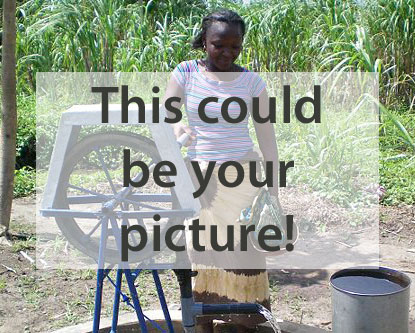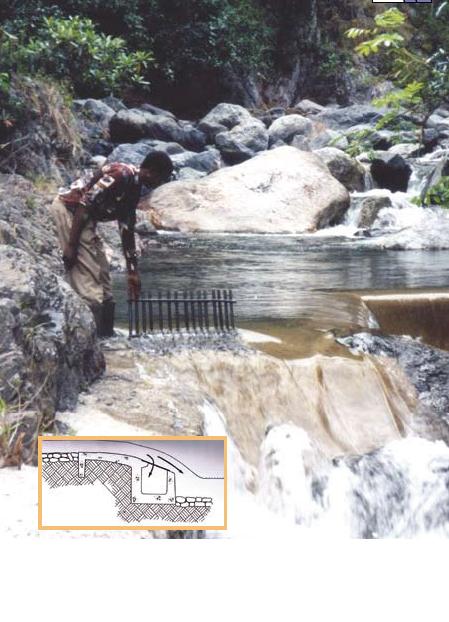Difference between revisions of "Water Portal / Rainwater Harvesting / Surface water / Tyrolean weir"
| Line 2: | Line 2: | ||
__NOTOC__ | __NOTOC__ | ||
[[Image:Tyrolean_weir_icon.png|right]] | [[Image:Tyrolean_weir_icon.png|right]] | ||
| − | [[Image:Tyrolean weir.JPG|thumb|right| | + | [[Image:Tyrolean weir.JPG|thumb|right|300px|Tyrolean weir]] |
A Tyrolean weir is a water inlet structure in which water is abstracted from the main flow through a screen over a gutter. The gutter is usually made of concrete and built into the river bed. The screen on the crest should slope downstream (15-30 degrees), to increase flow velocities and prevent sediment carried by the stream from blocking it. From the gutter, water enters a pipeline, which drains into a sedimentation tank and then flows by gravity into the rest of the system. | A Tyrolean weir is a water inlet structure in which water is abstracted from the main flow through a screen over a gutter. The gutter is usually made of concrete and built into the river bed. The screen on the crest should slope downstream (15-30 degrees), to increase flow velocities and prevent sediment carried by the stream from blocking it. From the gutter, water enters a pipeline, which drains into a sedimentation tank and then flows by gravity into the rest of the system. | ||
| Line 25: | Line 25: | ||
}} | }} | ||
| − | == | + | ==Construction, operations and maintenance== |
A Tyrolean weir can either consist of parallel rods or a perforated plate, installed in the flow direction over the width of the stream with a 15-30 degree downward slope. Large stones, branches and large leaves cannot pass between the rods, and are prevented from entering the gutter. Because the rods / plate slopes downward, the material in the stream is pushed downstream, until it drops over the end of the weir. | A Tyrolean weir can either consist of parallel rods or a perforated plate, installed in the flow direction over the width of the stream with a 15-30 degree downward slope. Large stones, branches and large leaves cannot pass between the rods, and are prevented from entering the gutter. Because the rods / plate slopes downward, the material in the stream is pushed downstream, until it drops over the end of the weir. | ||
| − | + | The threshold can be a concrete elevation above the rocky bed of a mountain stream, or a vertical low weir structure, anchored in the embankment. The capacity of the inlet pipe / drain (diameter and gradient) should be 30% more than the design flow and have an uniform gradient to prevent accumulation of sand. The sedimentation tank can accumulate 1.5-2 m<sup>3</sup> of deposits and allows water to filter for 10 to 30 minutes at very low speed. It is cleaned by washing it out. | |
====Maintenance==== | ====Maintenance==== | ||
| Line 35: | Line 35: | ||
Regular inspection and cleaning of the grit / rack and possibly the gutter and sedimentation tank is required during and after storm periods. | Regular inspection and cleaning of the grit / rack and possibly the gutter and sedimentation tank is required during and after storm periods. | ||
| − | == | + | ==Costs== |
| − | |||
| − | |||
| − | |||
| − | |||
| − | |||
| − | |||
| − | |||
| − | |||
* Material (excluding the pipe and sedimentation tank): US$ 300 - 600. | * Material (excluding the pipe and sedimentation tank): US$ 300 - 600. | ||
* Labour (if site is easily accessible): 30 - 50 man days. | * Labour (if site is easily accessible): 30 - 50 man days. | ||
| − | == | + | ==Field experiences== |
| − | |||
| − | |||
| − | |||
| − | |||
| − | |||
| − | |||
| − | |||
| − | |||
| − | |||
| + | ==Reference manuals, videos, and links== | ||
| + | ==Acknowledgements== | ||
{{Joinus}} | {{Joinus}} | ||
Revision as of 06:52, 27 April 2012
| |
A Tyrolean weir is a water inlet structure in which water is abstracted from the main flow through a screen over a gutter. The gutter is usually made of concrete and built into the river bed. The screen on the crest should slope downstream (15-30 degrees), to increase flow velocities and prevent sediment carried by the stream from blocking it. From the gutter, water enters a pipeline, which drains into a sedimentation tank and then flows by gravity into the rest of the system.
Dams and water inlet structures in embankments are vulnerable and expensive elements in river-fed water systems. They are easily damaged by floods, underflow, seepage and suffer from build-up of sediment or rubbish in the water. The Tyrolean weir forms a more reliable and cheaper alternative.
Suitable conditions
| ||||||
|
Tyrolean intakes are used in small permanent rivers and streams where the sediment content and bed load transport are low, or on the crest of a dam spill.
The weir or intake should be carefully sited.
The weir itself does not clean or purify the water.
| Advantages | Disadvantages/limitations |
|---|---|
| - More reliable and cheaper compared to dams and water inlet structures in river embankments |
Construction, operations and maintenance
A Tyrolean weir can either consist of parallel rods or a perforated plate, installed in the flow direction over the width of the stream with a 15-30 degree downward slope. Large stones, branches and large leaves cannot pass between the rods, and are prevented from entering the gutter. Because the rods / plate slopes downward, the material in the stream is pushed downstream, until it drops over the end of the weir.
The threshold can be a concrete elevation above the rocky bed of a mountain stream, or a vertical low weir structure, anchored in the embankment. The capacity of the inlet pipe / drain (diameter and gradient) should be 30% more than the design flow and have an uniform gradient to prevent accumulation of sand. The sedimentation tank can accumulate 1.5-2 m3 of deposits and allows water to filter for 10 to 30 minutes at very low speed. It is cleaned by washing it out.
Maintenance
Several visits per year to the site are necessary for inspection, cleaning and minor repairs. Overall, maintenance is easy to carry out due to low-tech structure and the use of local labour and materials.
Regular inspection and cleaning of the grit / rack and possibly the gutter and sedimentation tank is required during and after storm periods.
Costs
- Material (excluding the pipe and sedimentation tank): US$ 300 - 600.
- Labour (if site is easily accessible): 30 - 50 man days.
Field experiences
Reference manuals, videos, and links
Acknowledgements

|

